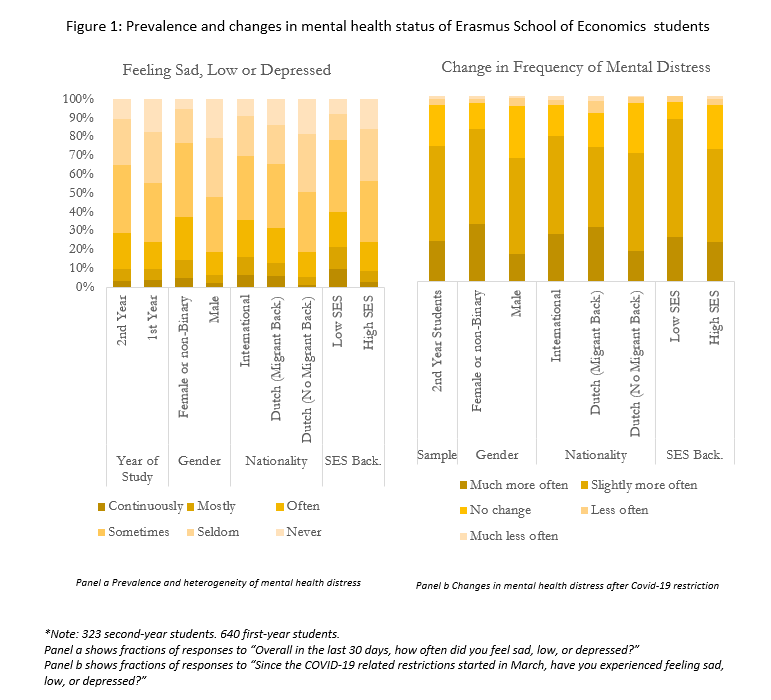One in every two individuals around the globe experience a mental health problem at least once in life (OECD, 2021) and each year this occurs among one in five individuals (OECD, 2018). Among (Dutch) university students these problems are prevalent and have increased during the COVID-19 pandemic. In this blog, we also show that prevalence is higher among disadvantaged groups, and that inequalities have widened during the pandemic. We call for policy action to tackle these problems and provide suggestions.
Mental health problems among university students
Before the start of the COVID-19 pandemic, around 20% of Dutch young adults had or were at risk of mental health problems (Van der Velden et al., 2019). Studies suggest that these have increased since then, also among university students in the Netherlands (Dopmeijer et al., 2021).
We surveyed first- and second-year students at Erasmus School of Economics (ESE) in the fall of 2020 (N=963, 43% response rate). 37% are female or non-binary, 30% are international students, and 16% are Dutch students with an immigrant background.
26% of the respondents report that they suffer often, mostly or continuously from sadness, low mood, and depression, and a striking 72% experienced a worsening in 2020 (Figure 1). Consistent with existing evidence, we find that mental health problems are more concentrated among international and Dutch students with a migrant background, female and nonbinary students (also broadly in line with Dopmeijer et al, 2021), as well as those with lower socioeconomic status. Additionally, our results suggest that the pandemic has widened these socioeconomic, ethnic and gender inequalities in mental health.

Policy recommendations
Given the high prevalence and worsening of mental health problems among university students during this critical period for human capital accumulation, there is scope for cost-effective interventions. There could be either supply-side (from the university, mental health system or other stakeholders), or demand-side policy interventions (tackling students’ attitudes towards mental health care and support).
On the supply-side, a smoother transition from childhood mental health care to adulthood mental-health care services is desirable. The sharp discontinuity in mental health care costs at age 18 in the Netherlands has concerning consequences for mental health care-seeking behavior of individuals around this age. Additionally, supply-side policies should focus on reducing waiting times and target high risk groups. Policies facilitating digital care and self-care (when appropriate) could partially tackle insufficient supply.
There have been several initiatives at Erasmus University Rotterdam (EUR) to support students’ mental wellbeing. For example, there are workshops and guidelines for students on mental health and wellbeing. Additionally, students have access to a wide range of online and offline services, including university psychologists, coaching, helpline, and peer-to-peer support. The effectiveness of some of these policies may be limited if there are barriers hindering individuals from seeking care (demand-side). Social- and self-stigma, low mental health literacy and awareness, and low autonomy are among the main demand-side barriers leading to sub-optimal care-seeking among young individuals. They potentially contribute to the existing gap between experiencing mental health problems and seeking support at EUR, even with easily accessible support services.
In addition, policies at the university should go beyond offering services to those already in distress and consider (educational) activities that may prevent these problems. Examples of such activities are: teaching skills to work under pressure and manage different deadlines (rather than taking for granted that these are innate skills), and activities where students share their challenges. Similarly, an education style that moves away from a mainly large scale and individualistic approach (with large classrooms and individual final exams), to also include activities (groupwork, discussions) in smaller and diverse groups, can potentially prevent students from feeling isolated. It is also important to increase awareness – both among staff and students – of this high prevalence of mental health problems and to challenge the competitive approach that facilitates seeing them as a failure.
Finally, the substantial uncertainty that remains regarding the type of educational activities and interaction allowed, as well as the continued necessity to quickly adapt, can be expected to exacerbate these problems.
References
Dopmeijer, J. M., et al. (2021). Monitor Mentale gezondheid en Middelengebruik Studenten hoger onderwijs. Deelrapport I. Mentale gezondheid van studenten in het hoger onderwijs.
OECD (2018, November). Promoting mental health in Europe: Why and how? In Health at a Glance: Europe 2018, pp. 19–43. Publisher: OECD.
OECD (2021), A New Benchmark for Mental Health Systems: Tackling the Social and Economic Costs of Mental Ill-Health, OECD Health Policy Studies, OECD Publishing
Van der Velden, P. G., Das, M., & Muffels, R. (2019). The stability and latent profiles of mental health problems among Dutch young adults in the past decade: a comparison of three cohorts from a national sample. Psychiatry research, 282, 112622.
Auteurs
Categorieën
1 reactie
It would be nice to see how representative this survey is given a response rate of 43%. I'm unfamiliar with the best practices in survey design, but I'd expect a correlation between mental health and willingness to fill out a survey.